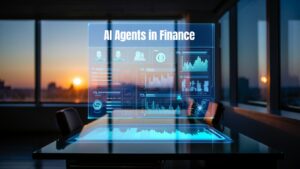Most enterprises that experiment with AI hit the same wall when pilots generate buzz, but scaling value stalls. A McKinsey survey (2025) found that while 78% of organizations now use AI in at least one function, fewer than one-third report meaningful bottom-line impact.
In businesses, generative AI has proven its value in producing high-quality outputs in customer responses, reports, and code. But without the ability to trigger next steps, such as routing tasks, applying compliance checks, or updating systems, workflows often remain incomplete and reliant on manual intervention.
Businesses use Agentic AI tools to manage workflows, compliance, system updates, and more.
Where generative AI excels at creation, agentic AI extends capabilities by reasoning, planning, and autonomously executing actions across enterprise workflows. Together, they enable organizations to move from isolated productivity wins to measurable operational impact.
In this article, you’ll learn the core differences between generative and agentic AI, their practical use cases across regulated industries, hybrid AI models that combine both strengths, and how RTS Labs helps enterprises implement AI that delivers measurable impact.
What is Generative AI?
Generative AI is a system that creates new content, such as text, images, code, or audio, by learning from large-scale datasets. These models, often powered by Large Language Models (LLMs), are designed to replicate patterns, style, and context from the data they’ve been trained on.
Traditional analytics tools only process or classify information, but generative AI actively produces original outputs. In a business context, its purpose is to automate content generation, accelerate knowledge tasks, and personalize customer-facing interactions at scale.
Generative AI is a system that creates new content, such as text, images, code, or audio, by learning from large-scale datasets. These models, often powered by Large Language Models (LLMs), are designed to replicate patterns, style, and context from the data they’ve been trained on.
Traditional analytics tools only process or classify information, but generative AI actively produces original outputs. In a business context, its purpose is to automate content generation, accelerate knowledge tasks, and personalize customer-facing interactions at scale.
For leaders, generative AI reduces repetitive work, shortens response times, and makes advanced capabilities, like personalized marketing or automated reporting, accessible without specialized technical expertise. Generative AI attracted $33.9 billion in private investment in 2024, an 18.7% increase over 2023.
How Generative AI Works
Generative AI relies on LLMs or diffusion models trained on massive corpora of data. A user provides a prompt, and the system generates original content by predicting the most likely next sequence of words, pixels, or code.
Here’s how Gen AI works:
1. Data Curation & Preprocessing
Collect text, images, or code. Clean, deduplicate, and normalize datasets. Remove PII and label samples where necessary.
2. Pretraining & Domain Adaptation
Train base models on broad corpora for general reasoning, then refine them on industry-specific or company data to boost accuracy.
3. Prompt Engineering
Design prompts, templates, and system instructions to guide the model’s outputs in format, tone, and compliance.
4. Output Generation
Run live prompts to generate text, visuals, or code. Tune parameters like temperature or top-p sampling to balance creativity with precision.
5. Post-Processing & Validation
Filter or normalize outputs, apply redaction and rule checks, and fact-check results before release.
6. Human-in-the-Loop (HITL)
Route edge cases to reviewers. Capture expert corrections to improve future outputs and reduce risk.
7. Integration & Workflow Embedding
Connect generated outputs directly into CRMs, claims platforms, or ticketing systems to create usable business workflows.
8. Monitoring & Retraining
Track KPIs like hallucination rate, latency, and satisfaction. Retrain or update prompts as requirements evolve.
9. Governance & Safety Controls
Apply explainability logs, access restrictions, bias audits, and compliance checks to maintain trust and meet regulations.
Key Components of Generative AI
Generative AI runs on a few core elements that work together to interpret prompts, process data, and generate relevant output. Here’s a quick look at its key components.
| Component | Description |
|---|---|
| LLMs (Large Language Models) | Core engines (e.g., GPT, Claude) trained on massive text datasets for contextual output |
| Training Data | The corpus of text, images, or code that shapes the AI’s responses |
| Prompt Input | User query or instruction guiding what content to generate |
| Output Generation | Text, image, or code produced in response to the prompt |
| Fine-Tuning | Custom training for industry or company-specific needs |
Real-world examples include widely recognized tools such as ChatGPT for conversational responses and knowledge queries, Midjourney for AI-generated images, and GitHub Copilot for code suggestions and automation.
In enterprise contexts, its applications span across critical functions, such as:
- Content automation, where organizations can generate reports, summaries, and marketing collateral at scale
- Marketing and personalization, enabling campaigns tailored to specific customer segments with higher precision
- Knowledge retrieval, giving employees or customers quick, AI-assisted answers without manual searches
- Customer support drafts, where the system instantly creates responses that human agents can review, refine, and finalize.
Generative AI adoption has been linked with measurable improvements, for example, faster resolution times, fewer reopened incidents, in live operations like security and endpoint management.
However, its scope is largely reactive. It produces outputs when asked, but doesn’t independently execute tasks or orchestrate workflows.
What is Agentic AI?
Agentic AI builds on generative AI but goes further. It not only creates content but also reasons, plans, and executes multi-step tasks autonomously. Instead of stopping at an output, agentic AI can use tools, APIs, and real-time data to take direct action.
Generative AI is reactive, but agentic AI is proactive, i.e., it is capable of carrying out workflows such as scheduling, filing claims, or triggering compliance checks without human micromanagement.
For enterprises, this is significant because it shifts AI from a productivity enhancer to an operational decision-maker.
When integrated, Agentic AI models help reduce bottlenecks, improve consistency, and accelerate outcomes in regulated or complex environments. Gartner predicts that by 2028, 33% of enterprise software applications will incorporate agentic AI, up from less than 1% in 2024.
How Does Agentic AI Work?
Agentic AI builds on generative AI capabilities but adds orchestration frameworks, tool integrations, and memory systems. These enable it to interact with APIs, databases, and enterprise systems, coordinating tasks from start to finish without constant human prompting.
Here’s a step-by-step process for building an Agentic AI tool:
1. Define goals & criteria
Set the agent’s objectives, allowed actions, and KPIs (e.g., task completion, error rates). Document runbooks and fallback rules.
2. Data design & ingestion
Identify data sources, clean and normalize them, and create secure pipelines with clear schemas and access controls.
3. Architecture & tools
Design components (reasoning engine, orchestration, connectors, memory, monitoring). Build secure, auditable API connectors and transactional safeguards.
4. Planning & reasoning
Implement a planner to decompose goals into tasks, manage contingencies, and log decisions for audit.
5. Memory & context
Provide both short-term session memory and long-term state with strict retention and access policies.
6. Human-in-the-loop
Define approval steps, SLAs, and reviewer interfaces. Capture corrections to improve future performance.
7. Testing & deployment
Validate with unit, integration, and adversarial tests. Deploy via controlled pipelines with rollback policies.
8. Monitoring & learning
Track KPIs like override rates and compliance incidents. Feed validated outcomes into retraining cycles.
9. Governance & scaling
Enforce access, bias audits, and compliance reporting. Scale gradually, starting with narrow tasks and expanding modularly.
Key Components of Agentic AI
Agentic AI brings autonomy to traditional AI systems by combining reasoning, memory, and tool use. The following components illustrate how it functions in real-world enterprise applications.
| Component | Description |
|---|---|
| Reasoning Engine | Enables the AI to plan tasks, break them into steps, and adapt if blocked. |
| Tool Use | Integration with APIs, databases, or external apps to take actions. |
| Memory | Retains context over time, improving long-term task execution. |
| Autonomy Layer | Orchestration frameworks (e.g., LangChain, AutoGPT) that enable multi-step workflows. |
| Feedback Loop | Continuous learning from outcomes to refine future decisions. |
It shifts the AI role from that of an assistant to an autonomous operator. Tools like AutoGPT enable autonomous multi-step task execution, while LangChain agents orchestrate LLM workflows by connecting models with tools and data. In practice, enterprises deploy AI customer service agents that not only draft responses but also resolve tickets end-to-end.
Its enterprise value lies in execution. Agentic AI can
- Detect fraudulent transactions and freeze accounts in real time
- Orchestrate compliance checks and approvals across business systems
- Monitor IoT feeds to predict equipment failures
- Proactively recommend or implement operational improvements.
A PwC executive survey found 79% of executives say AI agents are already being adopted in their companies, and 66% of those adopters report measurable value through increased productivity and cost savings.
By bridging the gap between insight and action, agentic AI elevates AI from reactive assistance to proactive execution, reducing delays, strengthening compliance, and delivering productivity gains that generative models alone cannot achieve.
Core Differences Between Agentic AI vs Generative AI
Generative AI and agentic AI share the same foundation in large models but diverge in their scope and impact. Generative AI focuses on content creation. Agentic AI extends this by embedding intelligence into business operations.
A few notable differences include:
| Factor | Generative AI | Agentic AI |
|---|---|---|
| Core Function | Generates text, images, code, or audio | Orchestrates workflows, reasons, and acts autonomously |
| Underlying Tech | LLMs, diffusion models | LLMs + orchestration frameworks (LangChain, AutoGPT), APIs, memory stores |
| Autonomy | Reactively acts when prompted | Proactively initiates and completes tasks |
| Business Value | Boosts productivity in knowledge and creative tasks | Transforms operations, speeds decision-making, reduces manual bottlenecks |
| Enterprise Integration | Enhances front-end functions (content, support) | Integrates deeply with CRMs, ERPs, claims, and compliance systems |
| Risks | Hallucinations, bias in outputs | Over-delegation, compliance missteps without governance |
| Industry Examples |
|
|
Real-World Use Cases
AI adoption only delivers true enterprise value when tied to practical applications. By looking at how generative and agentic AI operate in real-world industries like insurance, compliance, and supply chain, we can see where each adds measurable impact, from faster document drafting to autonomous decision-making.
Generative AI Use Cases
-
Insurance
- Drafts claims documents, policy summaries, and regulatory filings.
- Cuts manual review time, enabling faster policy issuance and compliance checks.
- Drafts claims documents, policy summaries, and regulatory filings.
-
Legal & Compliance
- Summarizes legal documents, contracts, and regulatory updates.
- Speeds up precedent research, allowing lawyers to focus on higher-value interpretation.
- Summarizes legal documents, contracts, and regulatory updates.
-
Supply Chain
- Generates reports on demand fluctuations and supplier performance.
- Equips leaders with timely insights for better planning and procurement decisions.
- Generates reports on demand fluctuations and supplier performance.
-
RTS Labs Integration
- Fine-tunes generative models with industry-specific data for accuracy.
- Embeds AI into insurance workflows (e.g., producing claim narratives that flow into downstream systems), reducing delays and administrative overhead.
- Fine-tunes generative models with industry-specific data for accuracy.
Agentic AI Use Cases
-
Insurance
- Triages claims automatically, routing suspicious cases to human review
- Approves low-risk claims without manual intervention, cutting cycle times
- Triages claims automatically, routing suspicious cases to human review
-
Compliance & Regulation
- Monitors regulatory changes across multiple jurisdictions in real time
- Flags violations and initiates reporting workflows, reducing compliance risks
- Monitors regulatory changes across multiple jurisdictions in real time
-
Supply Chain & Logistics
- Reroutes shipments when ports close or inventory levels drop
- Proactively minimizes disruption costs and ensures continuity
- Reroutes shipments when ports close or inventory levels drop
-
Healthcare & Capital Markets
- Builds AI agents to trigger clinical alerts, schedule interventions, or auto-execute trades under defined risk rules
- Ensures safety and governance with embedded compliance frameworks
- Builds AI agents to trigger clinical alerts, schedule interventions, or auto-execute trades under defined risk rules
Hybrid AI: Combining Generative and Agentic
The most forward-looking enterprises are no longer debating whether to choose generative or agentic AI. Instead, they’re building hybrid systems that merge the strengths of both. Generative AI provides the intelligence to create insights in the form of
summaries, reports, or tailored recommendations. Agentic AI then steps in to act on those insights, closing the loop with execution.
Example workflows illustrate the synergy:
- In insurance, generative AI reviews claim documents and extracts key details, while agentic AI validates the information, runs fraud checks, and initiates approvals.
- In the supply chain, generative AI forecasts demand shifts, and agentic AI automatically adjusts logistics schedules and supplier orders.
- In customer service, generative AI drafts empathetic responses, and agentic AI handles ticket resolution, refunds, or escalations.
RTS Labs specializes in designing hybrid AI frameworks that blend LLM-powered creativity with autonomous orchestration. It ensures both speed and reliability, embedding human-in-the-loop safeguards where needed. For businesses, hybrid AI means faster insights and faster action for measurable outcomes, growth, and ROI.
Generative AI vs Agentic AI: Challenges & Risks
As adoption accelerates, organizations must confront an increasingly complex set of risks.
Generative AI-specific risks:
- Hallucinations: Even advanced LLMs can generate convincing but inaccurate outputs.
- Bias and sensitive outputs: Without careful curation, generative AI may produce discriminatory or non-compliant responses, exposing firms to reputational and legal risks.
Agentic AI-specific risks:
- Misaligned autonomy: Over-delegation can lead to agents making unauthorized financial or operational decisions.
- Integration complexity: Connecting agents securely to CRMs, ERPs, and compliance systems necessitates a robust architecture and effective governance. Most modern infrastructure solutions still lack on that front.
Shared challenges:
- Data privacy and security: With sensitive data flowing across models and systems, enterprises face regulatory scrutiny.
- Explainability and accountability: In regulated industries, firms must show how decisions were made.
Recent findings reinforce these risks. According to McKinsey’s 2025 State of AI survey, fewer than one in five organizations track KPIs for AI deployments, making it harder to prove ROI or catch issues early. Larger enterprises were more likely to centralize risk oversight, but adoption gaps remain.
Also Read: AI Readiness Checklist in 2025
RTS Labs mitigates these challenges through AI governance frameworks, fine-tuning practices, and compliance safeguards for ensuring that innovation doesn’t outpace responsibility.
Agentic AI vs Generative AI: What Does the Future Hold
Looking ahead, several shifts will define the AI landscape:
- Multi-agent ecosystems: Companies will deploy fleets of AI agents coordinating tasks like supply chain monitoring, compliance reporting, and customer engagement.
- Agentic copilots: AI assistants that advise and execute, combining generative reasoning with agentic autonomy.
- Predictive workflows: LLMs will anticipate issues, like equipment failure and fraud risk, while agents act in real time.
- Blockchain + AI convergence: Immutable ledgers will serve as audit trails for agentic decisions, bolstering compliance and transparency.
Enterprises that prepare now will gain a sustainable advantage. By partnering with reliable providers like RTS Labs, organizations can build scalable frameworks that integrate these trends into real operations to ensure AI adoption keeps pace with innovation and regulatory demands.
The path from pilots to enterprise-scale AI requires clarity on where generative ends and agentic begins. Generative AI creates intelligence, while agentic AI operationalizes it. A hybrid strategy harnesses both, but execution requires a skilled partner.
RTS Labs brings deep expertise across domains like AI consulting & discovery, custom AI/ML development, hybrid AI Integration, and governance & Monitoring.
Also Read: Top AI consulting countries in USA
Organizations across insurance, compliance, supply chain, and capital markets trust RTS Labs to make AI usable, safe, and scalable. If you’re ready to go beyond experimentation, RTS Labs helps you transition from content generation to enterprise-wide intelligent action.
FAQs
Q1. What is the main difference between agentic AI and generative AI?
Generative AI produces content (text, images, code), while agentic AI reasons, plans, and executes tasks autonomously.
Q2. Which industries benefit most from agentic AI adoption?
Insurance, compliance, supply chain, and capital markets are industries where operational execution and risk management are critical.
Q3. Can generative AI tools be extended into agentic AI systems?
Yes. With orchestration frameworks, generative models can feed agentic agents, enabling both creation and action in workflows.
Q4. What are the biggest risks in deploying agentic AI?
Risks include over-delegation of decisions, integration complexity, and compliance missteps without governance.
Q5. How does RTS Labs help companies implement hybrid AI solutions?
RTS Labs guides adoption from strategy to execution, building custom models, integrating with enterprise systems, and ensuring compliance.






